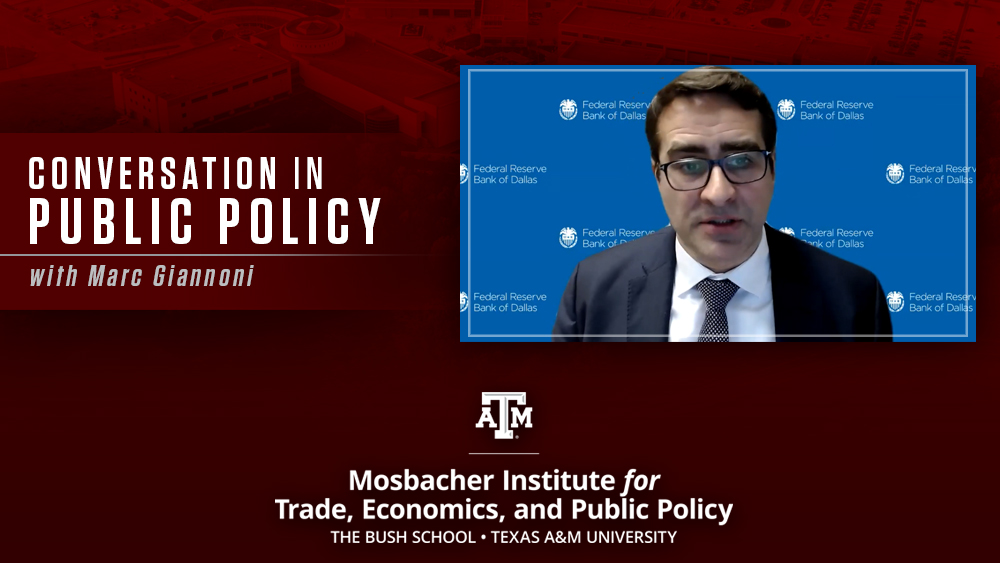
On December 2, 2021, the Mosbacher Institute for Trade, Economics, and Public Policy at Texas A&M University hosted a Conversation in Public Policy with Dr. Marc Giannoni, Senior Vice President and Director of Research at the Federal Reserve Bank of Dallas, titled “Economic Challenges in a Post-COVID World: Inflation, Supply Chains, and Labor Markets.” Giannoni’s presentation focused on three key points: that the current economic recovery is different from the post-Great Depression recovery, that there is currently a robust demand and constrained supply of labor, and that inflation is expected to remain moderately high next year.
Giannoni began his presentation by demonstrating the uniqueness of the current economic recovery. First, the COVID crisis brought about an unprecedented decline in economic activity. However, the recession was the shortest of its kind on record, and the subsequent rebound was sharp. Moreover, while demand is almost back to its pre-COVID levels, there are still supply constraints, and production has not returned to its previous trends. Second, thanks to government stimulus checks, personal income remained high, even when nominal salaries and wages dropped. By the time of his presentation, however, salaries and wages had returned to their normal levels. Third, overall consumption recovered from its initial sharp drop and went back to its pre-pandemic levels. However, the recovery was mainly in the consumption of goods, which surpassed its trend levels. Meanwhile, service consumption, such as those within the hospitality and airlines industries, has failed to recover to its pre-pandemic levels.
Giannoni then shifted the discussion towards the labor market conditions after the pandemic. He showed that, similar to consumption and overall economic activity, payroll employment fell sharply during the pandemic and quickly started to rebound. Although it has recovered significantly since the pandemic, it is still below its pre-pandemic levels. He attributed the slow recovery of employment not to the demand side but to the labor supply side, as job openings have hit near record levels. Several factors have contributed to constraining the labor supply side, including aging and retirements, fear of COVID-19, increases in family-care responsibilities, unemployment benefits, savings/asset appreciation, and changes in career preferences.
The final part of Giannoni’s presentation discussed current inflation trends. He argued that a combination of supply shortages in various products, such as semiconductors, as well as an increase in aggregate demand, which was boosted by government stimulus, has led to supply/demand imbalances. Such imbalances include goods as diverse as energy goods, food commodities, metals, and construction materials. These imbalances have in turn created broadening price pressures, which are expected to lessen over the next year. Hence, the inflation rate is expected to fall to around 2.7 percent in 2022, which is still higher than the Fed’s 2 percent target. He concluded by discussing the monetary policy responses made during the crisis, including maintaining a near zero Federal Funds Rate.
Following Giannoni’s presentation, Dr. Lori Taylor, Head of the Bush School’s Department of Public Service and Administration, engaged Giannoni with an exchange of her own and audience questions. Bush School students should note that Giannoni made clear that they are always looking for new talent and encouraged students to consider pursuing internships and careers at the Dallas Federal Reserve Bank.
You can view Giannoni’s talk on the Bush School YouTube channel.

